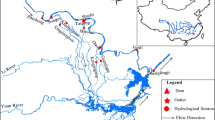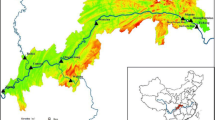Abstract
The impoundment of the Three Gorges Dam (TGD) has disturbed the hydrological regime downstream and has directly affected the relationship between the Yangtze River and Dongting Lake. To trace the realistic and potential impacts, this paper examined the changes of the channel morphology and sedimentology caused by the TGD through a field survey on the channel cross-sections and then analyzed the impact on lake water level through BP neural networks. The possible impacts on inundation patterns in lake wetlands were studied based on the lake basin DEM. The results indicate that drastic sediment decline and severe channel erosion are putting considerable pressure on the river and lake. Changing river channels are evident in some monitoring cross-sections. Dongting Lake, for the first time, changed from trapping to supplying net sediment to the Yangtze River. During the water storage periods of the TGD, the water level decreased 2.03 m in 2006 and 2.11 m in 2009 at the outlet of the lake, with extreme decreases up to 3.30 m and 3.02 m, respectively. These changes have inevitably induced alterations in the inundation patterns of the lake wetlands, which in turn have disturbed the ecological function of lake wetlands as habitats for both migratory birds and aquatic fish. The serious droughts in Dongting Lake recent years were largely connected with the above changes. Therefore, proper attention should be paid to this occurrence.





Similar content being viewed by others
References
Altinbilek D (2002) The role of dams in development. Int J Water Resour D 18:9–24
Cao FL, Conner WH (1999) Selection of flood-tolerant Populus deltoides clones for reforestation projects in China. Forest Ecol Manag 117:211–220
Chen ZY, Wang ZH, Finlayson B, Chen J, Yin DW (2010) Implications of flow control by the Three Gorges Dam on sediment and channel dynamics of the middle Yangtze (Changjiang) River, China. Geology 38:1043–1046
Christodoulou S (2011) Water resources conservancy and risk reduction under climatic instability. Water Resour Manag 25:1059–1062
Dai ZJ, Du JZ, Li JF, Li WH, Chen JY (2008) Runoff characteristics of the Changjiang River during 2006: Effect of extreme drought and the impounding of the Three Gorges Dam. Geophys Res Lett 35:L07406
Ding JQ, Mack RN, Lu P, Ren MX, Huang HW (2008) China’s booming economy is sparking and accelerating biological invasions. Bioscience 58:317–324
Dudley RK, Platania SP (2007) Flow regulation and fragmentation imperil pelagic-spawnfng riverine fishes. Ecol Appl 17:2074–2086
Dynesius M, Nilsson C (1994) Fragmentation and flow regulation of river systems in the Northern 3rd of the World. Science 266:753–762
Edmonds RL (1992) The Sanxia (3 Gorges) Project—the environmental argument surrounding China super dam. Global Ecol Biogeogr 2:105–125
Elderd BD (2003) The impact of changing flow regimes on riparian vegetation and the riparian species mimulus guttatus. Ecol Appl 13:1610–1625
Fuggle R, Smith W (2000) Large dams in water and energy resource development in the People’s Republic of China (PRC). Country review paper prepared as an input to the World Commission on Dams, Cape Town
Fuller IC, Large ARG, Milan DJ (2003) Quantifying channel development and sediment transfer following chute cutoff in a wandering gravel-bed river. Geomorphology 54:307–323
George PM (1864) Man and nature or physical geography as modified by human action. C. Scribner
Gregory KJ (2006) The human role in changing river channels. Geomorphology 79:172–191
Hill NM, Keddy PA, Wisheu IC (1998) A hydrological model for predicting the effects of dams on the shoreline vegetation of lakes and reservoirs. Environ Manage 22:723–736
Huang Q, Sun ZD, Jiang JH (2011) Analysis of impacts on the lake water level of Dongting Lake by the operation of the Three Gorges Reservoir. J Lake Sci 23:424–428
Hu YX, Huang JL, Deng F (2010) Using remote sensing to monitor wetland cover change and succession in Dongting Lake of China during 1993–2010. ICMT 5668–5672
Jiao L (2009) CHINA scientists line up against dam that would alter protected wetlands. Science 326:508–509
Kingsford RT (2000) Ecological impacts of dams, water diversions and river management on floodplain wetlands in Australia. Austral Ecology 25:109–127
Lane SN, Richards KS (1997) Linking river channel form and process: Time, space and causality revisited. Earth Surf Proc Land 22:249–260
Li JB, Zhu X, Cai BH (2001) Eco-agricultural patterns for disaster prevention in wetland restoration area of Dongting Lake. Journal of Natural Disasters 10:108–112
Li LQ, Lu XX, Chen ZY (2007) River channel change during the last 50 years in the middle Yangtze River, the Jianli reach. Geomorphology 85:185–196
Li YS, Sleigh AC, Ross AG, Williams GM, Tanner M, McManus DP (2000) Epidemiology of schistosoma japonicum in China: morbidity and strategies for control in the Dongting Lake region. Int J Parasitol 30:273–281
Ligon FK, Dietrich WE, Trush WJ (1995) Downstream ecological effects of dams. Bioscience 45:183–192
Liu TJ, Chen MQ (2001) Wetland ecological function deterioration in Poyang Lake and countermeasures. Chinese Journal of Ecology 20:74–77
Liu X, Guo S, Liu P, Chen L, Li X (2010) Deriving optimal refill rules for multi-purpose reservoir operation. Water Resour Manag 25:431–448
Lu XX (2004) Vulnerability of water discharge of large Chinese rivers to environmental changes: an overview. Reg Environ Chang 4:182–191
Marsh GP (1965) Man and nature: or, Physical geography as modified by human action (1864). Belknap Press
Merritt DM, Cooper DJ (2000) Riparian vegetation and channel change in response to river regulation: A comparative study of regulated and unregulated streams in the Green River Basin, USA. Regulated Rivers-Research & Management 16:543–564
New T, Xie ZQ (2008) Impacts of large dams on riparian vegetation: applying global experience to the case of China’s Three Gorges Dam. Biodivers Conserv 17:3149–3163
Nilsson C, Reidy CA, Dynesius M, Revenga C (2005) Fragmentation and flow regulation of the world’s large river systems. Science 308:405–408
Olson DM, Dinerstein E (1998) The global 200: A representation approach to conserving the Earth’s most biologically valuable ecoregions. Conserv Biol 12:502–515
Ostadrahimi L, Mariño M, Afshar A (2012) Multi-reservoir operation rules: multi-swarm PSO-based optimization approach. Water Resour Manag 26:407–427
Sala OE, Chapin FS, Armesto JJ, Berlow E, Bloomfield J, Dirzo R, Huber-Sanwald E, Huenneke LF, Jackson RB, Kinzig A, Leemans R, Lodge DM, Mooney HA, Oesterheld M, Poff NL, Sykes MT, Walker BH, Walker M, Wall DH (2000) Biodiversity—Global biodiversity scenarios for the year 2100. Science 287:1770–1774
Seto EY, Wu W, Liu HY, Chen HG, Hubbard A, Holt A, Davis GM (2008) Impact of changing water levels and weather on oncomelania hupensis hupensis populations, the snail host of schistosoma japonicum, downstream of the Three Gorges Dam. EcoHealth 5:149–158
Shen GZ, Xie ZQ (2004) Three Gorges Project: Chance and challenge. Science 304:681–681
Suen JP (2011) Determining the ecological flow regime for existing reservoir operation. Water Resour Manag 25:817–835
Thomas DHL, Adams WM (1999) Adapting to dams: agrarian change downstream of the Tiga Dam, northern Nigeria. World Dev 27:919–935
Thomas WL (1955) Man’s role in changing the face of the Earth. University of Chicago Press, Chicago
Tullos D (2009) Assessing the influence of environmental impact assessments on science and policy: An analysis of the Three Gorges Project. J Environ Manage 90:S208–S223
Wang Y, Li Z, Tang Z, Zeng G (2012) A GIS-Based spatial multi-criteria approach for flood risk assessment in the Dongting Lake region, Hunan, central China. Water Resour Manag 25:3465–3484
Xu K, Milliman JD, Yang Z, Wang H (2006) Yangtze sediment decline partly from Three Gorges Dam. EOS, Transactions 87:185–190
Yang GS, Ma CD, Chang SY (2009) Yangtze conservation and development report. 2009. Yangtze Press, Wuhan
Yang Z, Wang H, Saito Y, Milliman JD, Xu K, Qiao S, Shi G (2006) Dam impacts on the Changjiang (Yangtze) River sediment discharge to the sea: The past 55 years and after the Three Gorges Dam. Water Resour Res 42:W04407. doi:10.1029/2005WR003970
Yang SL, Zhang J, Xu XJ (2007) Influence of the Three Gorges Dam on downstream delivery of sediment and its environmental implications. Yangtze River Geophys Res Lett 34:L10401. doi:10.1029/2007GL029472
Yin HF, Liu GR, Pi JG, Chen GJ, Li CA (2007) On the river-lake relationship of the middle Yangtze reaches. Geomorphology 85:197–207
Zhao S, Fang J, Miao S, Gu B, Tao S, Peng C, Tang Z (2005) The 7-decade degradation of a large freshwater lake in central Yangtze river, China. Environ Sci Technol 39:431–436
Zhang N, He HM, Zhang SF, Jiang XH, Xia ZQ, Huang F (2011) Influence of reservoir operation in the upper reaches of the Yangtze River (China) on the inflow and outflow regime of the TGR-based on the improved SWAT model. Water Resour Manag 26:691–705
Yuan W, Yin D, Finlayson B, Chen Z (2011) Assessing the potential for change in the middle Yangtze River channel following impoundment of the Three Gorges Dam. Geomorphology, http://dx.doi.org/10.1016/j.geomorph.2011.06.039
Acknowledgements
This work was financially supported by the National Key Basic Research Program of China (No. 2012CB417003), and the Natural Science Foundation of China (No. 40801040). Special thanks for those colleagues who had assisted us with the field survey. Constructive comments from anonymous reviewers are gratefully acknowledged.
Author information
Authors and Affiliations
Corresponding author
Rights and permissions
About this article
Cite this article
Sun, Z., Huang, Q., Opp, C. et al. Impacts and Implications of Major Changes Caused by the Three Gorges Dam in the Middle Reaches of the Yangtze River, China. Water Resour Manage 26, 3367–3378 (2012). https://doi.org/10.1007/s11269-012-0076-3
Received:
Accepted:
Published:
Issue Date:
DOI: https://doi.org/10.1007/s11269-012-0076-3




